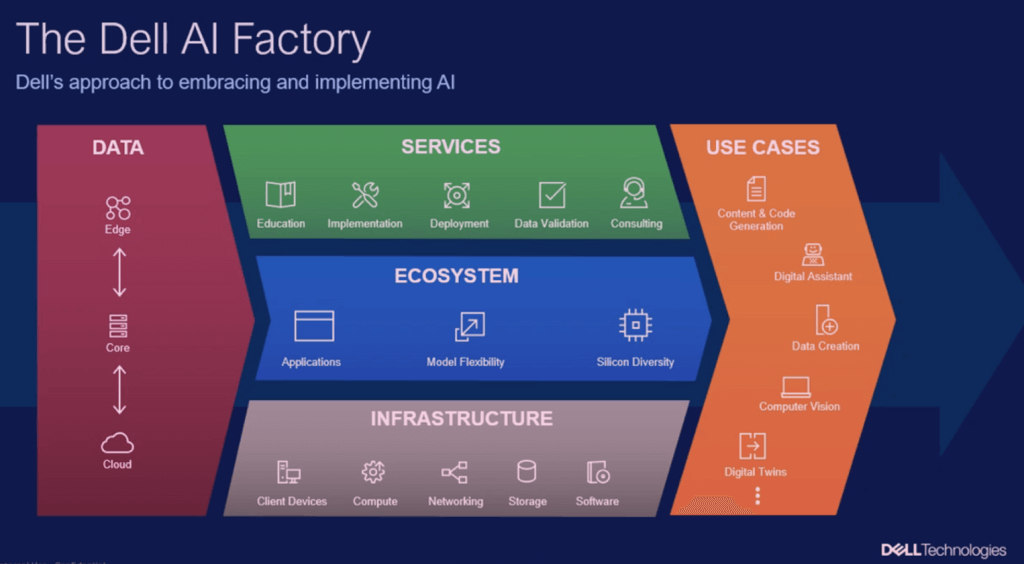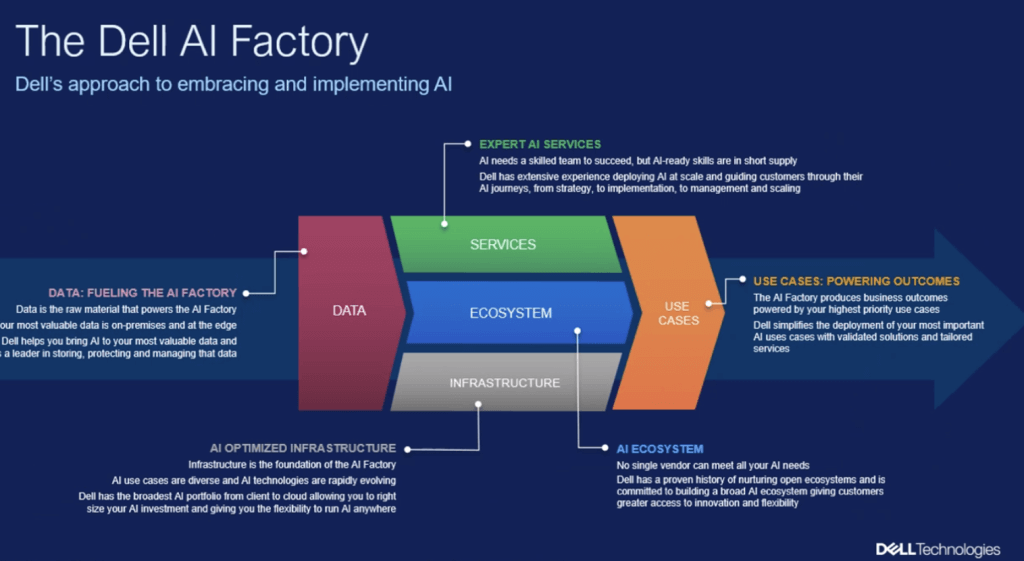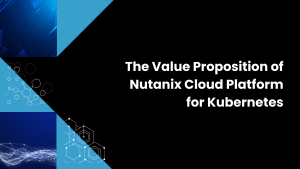Our team at theCUBE and theCUBE Research were on hand at Dell Technologies World this week, providing live coverage and featuring insightful interviews with Dell senior leaders, vendor partners, analysts, SMEs, and customers. Here are some highlights as it relates to thinking about how to accelerate AI adoption as well as how Dell is thinking about Edge as a long-term economic advantage.
Dell COO Jeff Clarke on the 5 Core Beliefs that Accelerate AI Adoption
The transformative potential of AI makes this an exciting time, and the topic of accelerating AI adoption was top of mind throughout Dell Technologies World event. In his keynote, Dell COO Jeff Clarke shared some of his thoughts on what organizations can do to embrace AI and accelerate its adoption throughout. Clarke’s five core beliefs that accelerate AI adoption include:
- Understand that data and how you manage it is a differentiator
- Develop a strategy to bring AI to your data, regardless of where it lives
- Now is the time to right size your IT
- An open and modular architecture is critical
- An open ecosystem is an important part of the path to success
I think it’s safe to say that the industry as a whole agrees that data is the key to maximizing the value of AI, wherever that data may be (e.g., on prem, the edge, etc.), and the strategy is to bring AI to your data, regardless of where it is.
Clarke also touched on the demands of AI compute and how they are expected to soar in the near term, and projected that we’ll see some flops within the space of a few years. Clarke spoke to a shift in inferencing tasks that he expects to see by 2030 and shared that 90% of computational demand will be focused there. On the sustainability front, he also warned of the additional power generation needs to meet data center needs as AI continues its upward trajectory.
With deep expertise in data storage, data protection, and data management tools, Dell has a clear advantage here. Moreover, integrating services, open ecosystems, and infrastructure to generate actionable insights with cognitive reasoning is what customers need — and that’s why Dell’s launch of the Dell AI Factory with NVIDIA is timely.
The Deets on Dell’s AI Factory
Dell’s core AI principles: prioritizing data, adaptable infrastructure, and an open ecosystem, align with addressing the challenges customers face today and the goal of Dell AI Factory with NVIDIA is clearly to help accelerate innovation. It’s also important to note that partnerships and alliances play an outsized role in success when it comes to driving AI advancements and overcoming challenges. We see those partnerships and alliances happening across the tech ecosystem and expect that to continue at an equally rapid pace. Today, there is no reason to go it alone, and do it all yourself. Best in class practices that deliver speedy results happen when vendors work together to solve customer problems.

The Compelling Value Prop of the Dell AI Factory
Dell is endeavoring to meet customers where they are, which I always like to see, and there are different ways to execute here. Some might choose to go it alone, some might opt for certain stack partners, others might want a fully managed solution, and others might want to buy or subscribe, with or without services included. Solutions and options that speak to those differing preferences as opposed to a one-size-fits-all approach are attractive.
The Dell AI Factory concept is a data center packaged differently for AI, and the open ecosystem is a big part of Dell’s value proposition here. It’s my workflow, my data, and my IP. We heard similar sentiments at IBM Think this week as week, from Red Hat president and CEO Matt Hicks, who spoke about the allure of small models. As Hicks stated, “It’s my thoughts, my data, my experiment – I run things on my laptop, as a developer at my core, running things in my control is an existential experience. This makes AI a tool for me, and I am not in service to a tool that is soaking up my ideas. That is a very powerful aspect.”
I see similarities in the way the team at Dell is thinking in terms of customer preferences and providing the right solutions to meet a variety of different needs and preferences and I like it. Dell shared that today it’s easier to manage smaller models and IP as people begin to get more accustomed to it, so I expect to see even more of this moving forward.
The Dell AI Factory combined with a commitment to an open ecosystem and these new assets are going to create value for customers in terms of increased productivity, cost reduction, and an increase in revenue, which is the trifecta everyone seeks. The below image is a bit of a deeper look at the nuances of the Dell AI Factory.

Without question, Dell has advantages here, with the wide range of data storage, protection, and data management tools they have ben developing. Infrastructure is the foundation of the Dell AI Factory, and customers will have use cases and applications that come in all shapes and sizes. Not everything requires a GPU, and not everything needs to run in the cloud. Having flexibility in the infrastructure layer is key, and that is where the breadth of the Dell portfolio can provide a serious assist, whether it’s running smaller workloads, or specific models on workstations, and up to working with the largest LLMs out there — and everything in between.
Right-sizing is an important part of the conversation and the team at Dell is focusing on helping customers right size according to the use cases they are prioritizing. Ecosystems, open ecosystems, and partnering with the right partners and forging strategic alliances is all part of Dell’s strategy, from silicon all the way to and through AI applications. Services also plays an important role here, as customers endeavor to build, deploy, and scale AI and focus on priority use cases — having a hand along the way helps speed things along.
The Dell AI Factory is not just one solution or product, it’s an end-to-end enterprise artificial intelligence (AI) solution designed to address the complex needs of enterprises. I find it particularly attractive that there are different ways you can consume it. Dell has built integrated solutions, brought in stack partners that include NVIDIA, of course, as well as AMD, Qualcomm, and Microsoft all for a wide-range of needs and use cases, and offer options that suit every use case. For example, if you want to buy, that’s great. Prefer to subscribe, that’s great, too. If you want fully managed, they can do that. Want fully managed across the whole thing, that’s fine, too.
I’m looking forward to watching the Dell AI Factory with NVIDIA offering unfold, and to hearing customer success stories once they are able to really dive in. I expect customers will find tremendous benefit from the uniqueness of the factory offerings, tailored to their needs, priorities, goals, and budgets, as well as providing them the ability to go fast or proceed a little more slowly — and all the while knowing they’ve got support from Dell and partners along the way.
Michael Dell on the Edge as a Long-Term Economic Advantage for Dell
Our team at theCUBE sat down with Dell founder and CEO Michael Dell at Dell Tech World, and he shared thoughts on the edge, the connection/convergence of IT and OT, and how he sees that as a long-term economic advantage for Dell. While AI PCs are no doubt something to be excited about, Dell spoke about the real opportunities that machines talking to machines present, which we’re already seeing in both the advanced manufacturing and retail sectors. Intelligent, connected machines, and data that brings IT and OT worlds together can benefit from Dell’s native edge platform, the native infrastructure platform Dell developed with AI built in, which allows the processing of data and intelligence in the physical world, where and when it’s happening and provides the ability to serve up better customer experiences across the board. And it’s significant that this is not the gigantic NVIDIA GPUs, but smaller versions of that that are able to process data and intelligence in real time, right where the “action” is happening.
See the full interview on theCUBE with Michael Dell here:
Breaking Analysis: Power Play in Hybrid AI: IBM and Dell on Display
In case you missed my colleague Dave Vellante’s Breaking Analysis column published earlier this week, he shared insights, analysis, and some deep, historical data dives, spending patterns and other trends powered by our research partner, ETR, in advance of both IBM Think and Dell Technologies World.
These companies are leading examples of hybrid AI players who we expect to reap big benefits from the AI wave that we are just beginning to ride.
Watch Power Play in Hybrid AI: IBM and Dell on Display here:
Check out some of our SiliconANGLE coverage from Dell Technologies World here:
Analyzing Dell’s AI Factory and its Positioning for Edge-centric Workloads
Collaboration Between Dell Technologies and Microsoft Extends Synergy Between APEX and Azure



